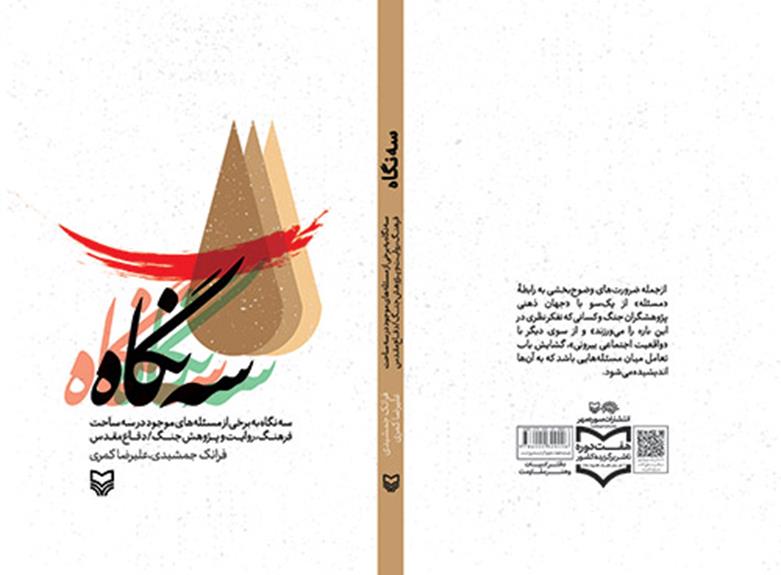"Three Views ... "and Questions that Cause the Audience to Think
Faranak Jamshidi
Translated by Ruhollah Golmoradi
2019-04-06
The symposium by Mr. Alireza Kamari has been published previously in two editions; one in book of Yade Mana (abiding memory), which contains five articles on memory-writing and memoirs of the war and the front and Sacred Defense, first published in 2002, and the other Puye Payedari (resistance movement), published in 2018, containing 40 articles and interview on resistance literature, the Islamic Revolution literature, the war literature and the holy defense literature, of which 9 from 33 articles are related to him, and 3 from 4 talks are with him (regardless of the 3 meetings that he was one of participants at the meetings).
Now, at the end of 1397 (SH), the Office for Literature and Art of Resistance and Sooreh Mehr Publication has published a book entitled "Three Views on the Issues in Three Areas of "Culture", "Narrative" and "Research" of the War/"Holy Defense", which is another selection of articles by Mr. Kamari. This book contains 18 articles in three mentioned areas. I think it is a more effective way to persuade the audience to study the book if I concentrate this introduction on the most important questions that the book has responded to them.
Some of these questions in field of culture (including language and literature and art) the war / sacred defense are:
-What caused the eight-year war to be reflected mainly in literary and artistic language, as literature and art of the war could be regarded as the second occurrence of event in mind and language?
-Why among the three titles of the "eight-year war between Iran and Iraq", "imposed war" and "sacred defense" has the last title been used and fashioned more?
-What is relationship between resistance of Iranian people during the revolution and the eight-year war with Iraq and being effected by culture of Ashura?
- What factors have caused language and media thought in talking and writing about the eight-year war to be occasion-oriented?
-What has contributed to paradox of war and humor among people of the front?
-And...
Also, some of questions that Mr. Kamari addressed to them in area of narrative (including memory and history) the War/Holy Defense are:
-Why cannot it be accepted that an individual or an institution succeeds in presenting pure narrative of the real in war of Iran and Iraq? Or, in other words, why neither memory nor history can present a completely identical narrative to the real version of the event?
-Why, before the eight-year war, historiography of the war was not formed as an independent branch in historiography of Iran? What is relationship between the eight-year war and emerging an independent branch called "war/sacred defense historiography"?
-Why, in discussing narrative of the Iran-Iraq war, one cannot ignore narration of martyr Avini's Revayat-e Fath, and why does not result any attempt for Avini studying without viewpoint of relationship between Avini and narrative in a desirable outcome? What are the obvious and unclear links between narrative of Avini and development of sacred literature through war/sacred defense literature?
-What is relationship between paraphrasing "catastrophe" of the eight-year war to "disaster" and directing works of the war to memories and gradual concentration of memories around the "sanctified defense"?
-Can there be a connection between memories of the war/sacred defense, historiography, and historiography of the war/sacred defense?
-What are some differences and shortcomings that exist between what is currently present about recognizing and collecting, providing and compiling, and producing and publishing memories of the war/sacred defense, and what logically should be existed in terms of should and should not of documentary, and what is way for go out of these dilemmas?
- And...
In addition to these two areas, some of the questions Mr. Camry addressed to them in field of studying the war/sacred defense include:
What is the gap between what is expected from the war/sacred defense research and current situation? What are obstacles to prevent the desired and expectant situation?
How many of necessities of the war/sacred defense research could be carry out by efforts of conducting and implementing semiotic studies of the war / sacred defense, and to what extent does it stimulate interdisciplinary collaborations in the war/sacred defense research and studies?
The plan for harmonization of martyrs' grave shows what gap between views of authorities and executives of the project with a research-focused viewpoint in terms of recognizing place of graves in cultural, historical, document, literary and artistic studies of the war/holy defense?
What norm-breakings is expected to be happened in field of document and predicative studies of the war and discussions on citation because of efforts to recognize, collect, typify, rationalize, study, and research about new emergent types of citation?
-And...

Number of Visits: 4926
http://oral-history.ir/?page=post&id=8470
